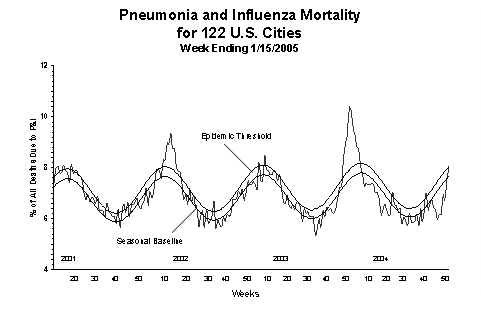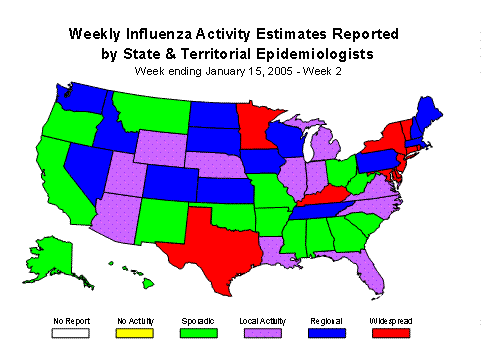US CDC. US:Weekly Report: Influenza Summary Update week 02,2005. US CDC
| Weekly Report: Influenza Summary Update Week ending January 15, 2005-Week 2 |
|
The following information may be quoted:
Synopsis:During week 2 (January 9-15, 2005)*, influenza activity continued to increase in the United States. Three hundred ninety (14.6%) specimens tested by U.S. World Health Organization (WHO) and National Respiratory and Enteric Virus Surveillance System (NREVSS) collaborating laboratories were positive for influenza viruses. The proportion of patient visits to sentinel providers for influenza-like illness (ILI) is above the national baseline and the proportion of deaths attributed to pneumonia and influenza is above the epidemic threshold. There have been two influenza-associated pediatric deaths reported to CDC this season. Ten states and New York City reported widespread influenza activity, 14 states reported regional influenza activity, and 11 states reported local activity. Fifteen states, the District of Columbia, and Puerto Rico reported sporadic influenza activity.
Laboratory Surveillance*:During week 2, WHO and NREVSS laboratories in the United States reported testing 2,672 specimens for influenza viruses, of which 390 (14.6%) were positive. Of these 50 were influenza A (H3N2) viruses, 299 were influenza A viruses that were not subtyped, and 41 were influenza B viruses.Since October 3, WHO and NREVSS laboratories in the United States have tested a total of 45,180 specimens for influenza viruses and 2,922 (6.5%) were positive. Among the 2,922 influenza viruses, 2,508 (85.8%) were influenza A viruses and 414 (14.2%) were influenza B viruses. Seven hundred eight (28.2%) of the 2,508 influenza A viruses have been subtyped; 704 (99.4%) were influenza A (H3N2) and 4 (0.6%) were influenza A (H1N1) viruses. The largest numbers of specimens testing positive for influenza have been reported from the New England (721) and Mid-Atlantic (755) regions. The percentage of total isolates that are influenza type A is the highest in these same regions; 98% A in the New England region and 97% A in the Mid-Atlantic region. Influenza A viruses represent a smaller proportion of positives in the other 7 regions, ranging from 90% in the East North Central region to 58% in the Mountain region.
Antigenic Characterization:CDC has antigenically characterized 177 influenza viruses collected by U.S. laboratories since October 1, 2004: 2 influenza A (H1) viruses, 122 influenza A (H3N2) viruses, and 53 influenza B viruses. The hemagglutinin proteins of the influenza A (H1) viruses were similar antigenically to the hemagglutinin of the vaccine strain A/New Caledonia/20/99. One hundred sixteen of 122 (95%) influenza A(H3N2) isolates were characterized as antigenically similar to A/Wyoming/3/2003, which is the A/Fujian/411/2002-like (H3N2) component of the 2004-05 influenza vaccine. Six (5%) influenza A(H3N2) isolates had reduced titers to A/Wyoming/3/2003 and are most closely related to a recent reference strain, A/California/7/2004 (H3N2). Forty of the influenza B viruses isolated this season belong to the B/Yamagata lineage and were characterized as B/Shanghai/361/2002-like, which is the influenza B component recommended for the 2004-05 influenza vaccine, and 4 showed somewhat reduced titers to ferret antisera produced against B/Shanghai/361/2002. Nine influenza B viruses belong to the B/Victoria lineage.Influenza B viruses currently circulating can be divided into two antigenically and genetically distinct lineages represented by B/Yamagata/16/88 and B/Victoria/2/87 viruses. B/Yamagata lineage viruses circulated widely between 1990 and 2001 during which time B/Victoria-like viruses were not identified outside of Asia. However, between March 2001 and October 2003, B/Victoria-like viruses predominated in many countries, including the United States, and the vaccine strains were changed accordingly. While both Victoria lineage and Yamagata lineage viruses have been reported worldwide during the past year, Yamagata lineage viruses have once again become predominant.
Pneumonia and Influenza (P&I) Mortality Surveillance*:During week 2, 8.1% of all deaths reported by the vital statistics offices of 122 U.S. cities were attributed to pneumonia or influenza. This percentage is above the epidemic threshold of 8.0% for week 2.
Influenza-Associated Pediatric Mortality*:Two pediatric deaths have been reported to CDC: one from Maine in week 1 and one from Massachusetts in week 2.
Influenza-Associated Pediatric Hospitalizations:The New Vaccine Surveillance Network consists of three sites in Cincinnati OH, Nashville TN, and Rochester NY. The sites conduct population-based surveillance for laboratory-confirmed influenza among children 0–4 years of age who are admitted to the hospital with fever or acute respiratory illnesses. During October 3 2004 – January 8, 2005, the preliminary influenza hospitalization rate for children 0–4 years old was 0.6 per 10,000 children based on 6 laboratory-confirmed inpatient cases. Hospitalization rate estimates are preliminary and may change as data continue to be collected. In years 2000–2003, the end-of-season hospitalization rate ranged from 3.7 to 12.0 per 10,000 children.The Emerging Infections Program (EIP) is collecting data in 10 sites on hospitalizations of children <18 years of age with illnesses associated with laboratory-confirmed influenza. Hospitalization data from the EIP sites will be included as they become available.
Influenza-like Illness Surveillance*:During week 2, 2.6%*** of patient visits to U.S. sentinel providers were due to ILI. This percentage is above the national baseline of 2.5%. The percentage of visits for ILI ranged from 1.6% in the East South Central region** to 4.3% in the Pacific region. Due to wide variability in regional level data, it is not appropriate to apply the national baseline to regional level data.
Influenza Activity as Assessed by State and Territorial Epidemiologists*:During week 2, 10 states (Connecticut, Delaware, Kentucky, Maryland, Minnesota, New Jersey, New York, Rhode Island, Texas, and Vermont) and New York City reported widespread activity. Fourteen states (Colorado, Idaho, Iowa, Kansas, Maine, Massachusetts, Nevada, New Hampshire, North Dakota, Pennsylvania, South Dakota, Tennessee, Washington, and Wisconsin) reported regional influenza activity. Eleven states (Arizona, Florida, Illinois, Indiana, Louisiana, Michigan, Nebraska, North Carolina, Utah, Virginia, and Wyoming) reported local activity. Fifteen states (Alabama, Alaska, Arkansas, California, Georgia, Hawaii, Mississippi, Missouri, Montana, New Mexico, Ohio, Oklahoma, Oregon, South Carolina, and West Virginia), the District of Columbia, and Puerto Rico reported sporadic influenza activity.-------------------------------------------------------------------------------- * Reporting is incomplete for this week. Numbers may change as more reports are received. ** Surveillance Regions: New England (Connecticut, Maine, Massachusetts, New Hampshire, Vermont, Rhode Island); Mid-Atlantic (New Jersey, New York City, Pennsylvania, Upstate New York); East North Central (Illinois, Indiana, Michigan, Ohio, Wisconsin); West North Central (Iowa, Kansas, Minnesota, Missouri, Nebraska, North Dakota, South Dakota); South Atlantic (Delaware, Florida, Georgia, Maryland, North Carolina, South Carolina, Virginia, Washington, D.C., West Virginia); East South Central (Alabama, Kentucky, Mississippi, Tennessee); West South Central (Arkansas, Louisiana, Oklahoma, Texas); Mountain (Arizona, Colorado, Idaho, Montana, Nevada, New Mexico, Utah, Wyoming); Pacific (Alaska, California, Hawaii, Oregon, Washington) *** The national and regional percentage of patient visits for ILI is weighted on the basis of state population. Report prepared: January 20, 2005. |
See Also:
Latest articles in those days:
- [preprint]Mass mortality at penguin mega-colonies due to avian cholera confounds H5N1 HPAIV surveillance in Antarctica 13 hours ago
- [preprint]How the 1918-1920 Influenza Pandemic Spread Across Switzerland - Spatial Patterns and Determinants of Incidence and Mortality 13 hours ago
- Influenza C Virus in Children With Acute Bronchiolitis and Febrile Seizures 17 hours ago
- Feasibility and Safety of Aerosolized Influenza Virus Challenge in Humans Using Two Modern Delivery Systems 17 hours ago
- Avian Influenza Weekly Update # 1026: 12 December 2025 1 days ago
[Go Top] [Close Window]







